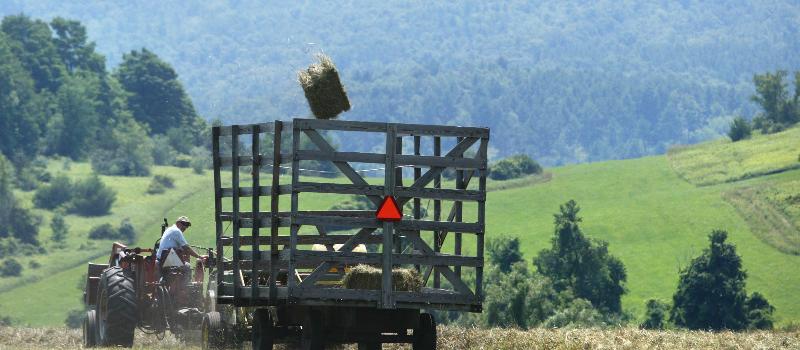154 ACRES conserved IN THE TOWN OF HOOSICK
The Philpott farm is located smack across the road from where the Rutland railroad line crosses the Boston and Maine (B&M) in the Hoosic River Valley. That was a big advantage at the turn of the century when fluid milk was shipped by train.
Earl and Etta Philpott bought the farm, including the 1740 Bratt Mansion, in 1936. The Philpotts started out raising dairy cows and hens on their 155 acres. Their son Carleton began working full-time on the family farm in 1951. Not long afterward, he married Corinne and decided to start a family. To bring in extra income, Carleton drove a daily truck route, collecting milk from other farmers. He delivered the milk to the United Dairy System creamery at the Hoosick train station. Milk cans were loaded onto the refrigerated train cars every day at 9 a.m. The creamery is still there today, just behind Curtis Lumber.
By the 1960s, milk was mostly moved in long-haul refrigerated trucks on highways. The B&M made the last delivery of bulk milk from Eagle Bridge to Boston in 1972. Farmers, including Carleton, had to invest in bulk holding tanks and increase their herd size to survive. Tanker trucks began coming to the farm every other day to pick up milk and ship it to Springfield, MA for pasteurization. There, the milk was separated and bottled or made into cheese.
A commitment to agriculture and a rural way of life
“We had several opportunities to sell because of the railroad,” said Carleton. “But you get up in the back and you’re looking at some of the finest farmland in the Hoosick Valley. It’s important to us and the Hoosick community that future generations are able to farm this land,” he said. The farm’s dead level fields are sandwiched between the B&M Railroad line and the Hoosic River. “There isn’t a stone in them,” he says. There have been many people who wanted to build on those flat, fertile fields. But he and Corrine never considered selling.
In what Carleton and Corrine jokingly refer to as a “semi-retirement plan,” Carleton transitioned the business from dairy to hay and corn production in 1998. Thanks to the farm’s proximity to neighboring farms and his reasonable prices, Carleton built a niche market in the area. When he was finally ready for “real” retirement 14 years later, he leased the fields to a neighboring dairy operation for support land. He also created a trust so son Christopher will inherit the farm.
With the protection of the Philpott Farm, there will now be a block of nearly 1,500 agricultural acres conserved along the Hoosic River in New York and Vermont. Contiguous blocks of farmland strengthen the long-term agricultural viability of the area as well as the individual farms. Farmers have the security of knowing that there will be land available for farming, while large blocks of farmland minimize potential conflicts with non-farming neighbors. Additionally, these large blocks enable neighboring farms to work collaboratively and exchange resources.
“Preserving the agricultural heritage of our community and keeping this land available for farming in the future has always been our goal.” – Carleton Philpott
Funding for this project was provided by the New York State Environmental Protection Fund administered by the Department of Agriculture and Markets and the federal program, formerly known as the Farm and Ranch Lands Protection Program administered by the United States Department of Agriculture Natural Resource Conservation Service.





